WooCommerce custom taxonomies: The easy way to display extra product data & filters

WooCommerce comes with various fields for storing product data. There's the product name, long and short description, price, images, stock, weight, dimensions, etc. But what happens if you want to store and display extra product data, such as WooCommerce custom taxonomies?
In this article, I walk you through creating WooCommerce custom taxonomies for products. We'll look at the difference between WooCommerce custom fields and taxonomies. Also, we'll consider the different types of product data. You will also learn how to add custom taxonomies to store extra information about WooCommerce products.
At the end of this guide, you will have mastered how to:
- Add WooCommerce custom taxonomies to your products. We'll use the free Easy Post Types and Fields plugin for this.
- Display products with their taxonomies in a structured table layout on your website. We’ll do this with the easy-to-use WooCommerce Product Table plugin.
- Let customers filter your list of products by taxonomy. We'll use the WooCommerce Product Filters plugin for this.
And remember, you can do all this without writing a single line of code!
Ready to start displaying products with custom fields & taxonomies? But before we dive in, let's quickly examine how to create and display a WooCommerce custom product taxonomy.
What is product taxonomy?
A product taxonomy is a means of structuring products into different groups and subgroups based on their features, attributes, and characteristics. It enables customers to find the products they want without wasting time. It also helps you as a seller organise your products, which makes it easier to manage your inventory, sales and marketing effort.
The categorization can be based on size, colour, style, materials, target market, price range, or anything else.
What is a WooCommerce custom taxonomy?
In WooCommerce, a custom taxonomy organizes and classifies products to show advanced custom fields beyond the standard product categories and tags. It allows you to group products based on specific product attributes using hierarchical or non-hierarchical groupings.
To create a custom taxonomy in WooCommerce programmatically, you might have to use a new set of labels. Besides, you'll have to register the taxonomy with the WordPress core and associate the taxonomy you wish to classify.
An easier option is to create a WooCommerce taxonomy using a WordPress plugin. You can use a plugin to create custom taxonomies such as brands, sizes, seasons, materials, and other relevant product data. Keep reading to discover the best WooCommerce taxonomy plugins for creating, displaying, and filtering taxonomies.
What are the benefits of using WooCommerce custom taxonomies?
Using WooCommerce custom taxonomies provides many benefits. These include better product organization, enhanced filtering, improved navigation, flexibility, and higher visibility. Integrating relevant keywords in your custom taxonomy terms enables more laser-focused product pages for better SEO.
What's the difference between WooCommerce custom fields and taxonomies?
We usually use the phrases 'custom fields' and 'custom taxonomies' in relation to WooCommerce product data. However, many people don't know exactly what they are and their differences. WooCommerce custom fields are used to store arbitrary, one-off information about a product. On the other hand, custom taxonomy is used for grouping things together. This reflects in the way you add custom fields and custom taxonomies for products in the WordPress admin:
Custom fields appear in the main column of the Add/Edit Product screen. This is where you add other unique product data such as title, description, price, etc.
In contrast, custom taxonomies appear in the right-hand column under the product categories and tags. Each WooCommerce taxonomy term should be selected for multiple products like categories and tags.
When should I use custom fields & when should I use a WooCommerce taxonomy?
Once you understand the difference between a WooCommerce custom field and taxonomy, it becomes more obvious when to use each one.
As a rule of thumb, you can decide between custom fields and taxonomies by asking: "Is the data I am adding unique to each product, or does it apply to multiple products?" If the data is unique for each WooCommerce product, you need a custom field. However, if you want to select the same value for several products and use it to group them together (e.g., via a product filter), then you need a WooCommerce taxonomy.
Here are some examples to help you choose:
- WooCommerce clothes store displaying the color of each product. If you're selling clothes in WooCommerce, you'll probably want customers to be able to find products by color. You'll have multiple products of each color. By creating a WooCommerce custom taxonomy called 'Colour', customers can filter the list of products to find the color they like. This wouldn't be possible with a custom field.
- WooCommerce second-hand site storing 'condition' information about their used products. If you're selling used goods like eBay, you'll need a field to store details of any damage, etc. The description of each item's condition will be unique to that product, so you should create a WooCommerce custom field.
- WooCommerce product directory with a large product database. WooCommerce directory-style websites with large numbers of products often list extra product data within the directory listings view. For example, a book directory might include data for author, publisher, and year.
Use custom fields and taxonomies together
To use the 2nd example above, a store selling used goods might want a WooCommerce taxonomy called 'Condition' AND a custom field called 'Condition Description'. The 'Condition' taxonomy would include the terms "New," "As New," and "Used," which apply to multiple products.
You could create product filters so customers can narrow their search based on the overall condition. The 'Condition Description' custom field would provide unique information about the exact condition of the product and any damage.
Video tutorial - WooCommerce custom fields & taxonomies
In this video tutorial, you can watch us create WooCommerce taxonomies and custom fields and display them on a WordPress website. There are also full written instructions below:
How to create a WooCommerce custom taxonomy
Easy Post Types and Fields is the best plugin for creating a custom taxonomy for WooCommerce products. It's 100% free and has everything you need to add extra taxonomies to your store.
WooCommerce products are custom post types in WordPress. That's why you need a plugin which lets you add taxonomies to a WordPress post type.
Other plugins like Advanced Custom Fields (ACF) let you create custom fields but not taxonomies. Easy Post Types and Fields lets you do both.
Next, I'll show you how to create WooCommerce custom taxonomies with the free Easy Post Types plugin. After that, you'll learn how to display them on the front end, and how to let customers filter by taxonomy.
Setup instructions
Here's how to use Easy Post Types as a WooCommerce custom taxonomy plugin:
-
- Go to Plugins → Add New in the WordPress admin and search for 'Easy Post Types and Fields'.
- Install and activate the plugin by Barn2. Skip through the setup wizard because you don't need to create a new post type.
- Go to the 'Post Types' section on the left of the WordPress admin and click on the 'Existing Post Types' tab.
- Find the 'Products' post type and click on the Taxonomies button for it.
- Now set up your WooCommerce custom taxonomy:
- Add the Taxonomy Slug (ideally 1 word, lowercase).
- Add a plural and singular name (label). This will only appear in the WordPress admin.
- Choose whether or not you want the custom taxonomy to be hierarchical. Hierarchical taxonomies are like product categories, where you can create multi-level nested structures with parent and child categories. Non-hierarchical taxonomies are like tags, which are flat and can't be structured.
- Click to add the taxonomy to WooCommerce.
Now go to the Edit Product page, and you'll see the custom taxonomy on the right-hand side, under the categories and tags. Add one or more taxonomy terms for each product, just like standard product tags.
You'll also see a section for managing your new WooCommerce taxonomy under the 'Products' section of the WordPress admin. For example, if you created a taxonomy called 'Brand' then a 'Brands' link will appear there.
Related: The ultimate guide to WooCommerce Brands.
Displaying WooCommerce custom taxonomies on the front end
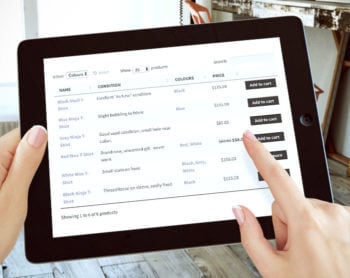
But the good news is that there's a handy WordPress plugin to list products in a table and extra data, such as WooCommerce custom taxonomies. It's an ideal way to display products with extra information, as everything is presented in a structured tabular format. You can add product tables to any WordPress page, your main WooCommerce shop or product category pages, or even a single product page.
The WooCommerce Product Table WordPress plugin is one of the best for displaying custom taxonomies. This is because it supports all the usual WooCommerce product data, plus custom fields and custom taxonomies. Each item of product data is listed as a separate column in the table.
Customers can search or sort the table by any product custom taxonomy term. They can also filter by taxonomy via handy dropdown lists above the table. The WordPress plugin allows you to create WooCommerce tables with only products as a specific taxonomy term.
Comparatively, this is much easier than modifying your WooCommerce template files. Moreover, you get all the other benefits from product table layouts, such as improved conversion rates.
How to create product tables with WooCommerce custom taxonomies
Setting up a WooCommerce Product Table with all the extra product data is easy:
- Get WooCommerce Product Table. Download the WordPress plugin using the link on the order confirmation page and email.
- In the WordPress admin, go to Plugins → Add New. Upload the plugin files, and install and activate the plugin.
- Navigate to Products → Product Tables and set up your first table.
Below, I'll tell you which settings to choose to display WooCommerce custom taxonomies in different ways.
Display custom taxonomies on the WooCommerce shop page or product category archive
The first page of the product table builder lets you choose which method you'll use to add the table. Select the "Display on a shop page (e.g. main storefront, category page, etc.)" option.

On the following page, choose which templates to display the custom taxonomies table on.
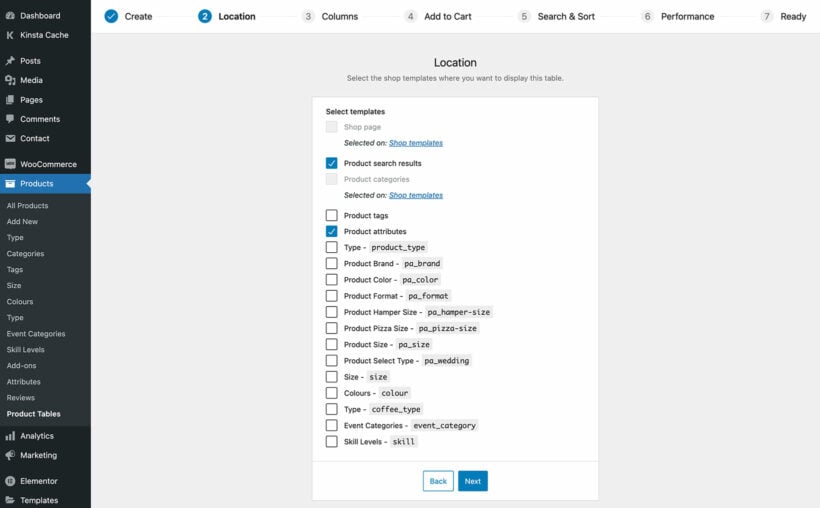
Use the 'Columns' page of the table builder to choose what product data to display. All the custom taxonomies for the 'Products' post type in your store will appear in the list of columns. Select as many as you need, and use the pencil icon to rename the column heading.
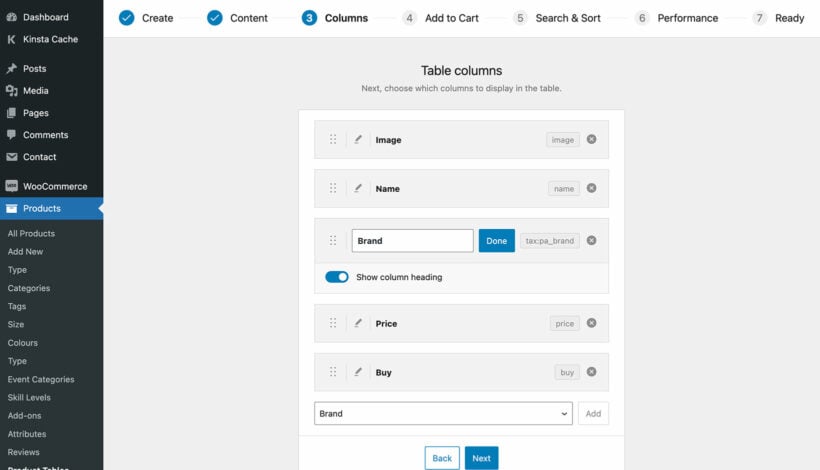
This will add the product table to your main shop page and whichever other template pages you selected. The list of products will include the WooCommerce custom taxonomies.
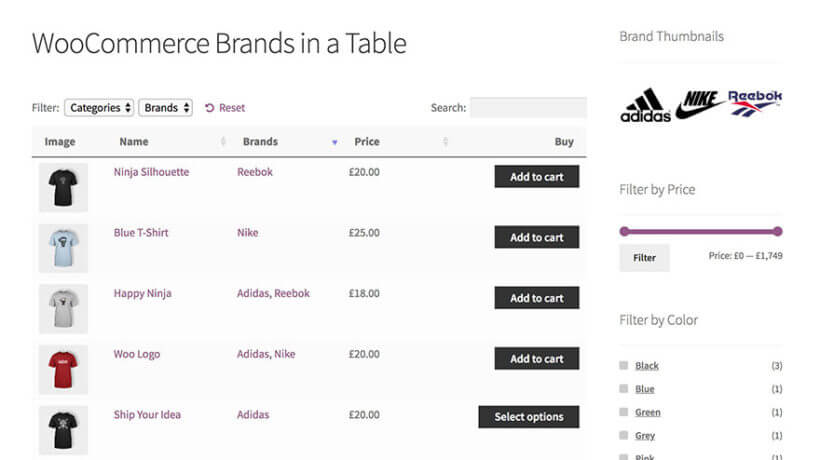
How to list products with WooCommerce taxonomies on a standard page
Alternatively, you can add product tables to normal WordPress pages with custom taxonomy columns. This will look similar to the screenshot above, but won't affect your main shop pages.
The instructions for this are mostly the same as above. However, you should select "Add to a page using a block or shortcode" at the start of the table builder.

On the following page, either leave it set to "All products" or select which products you wish to list in the table.
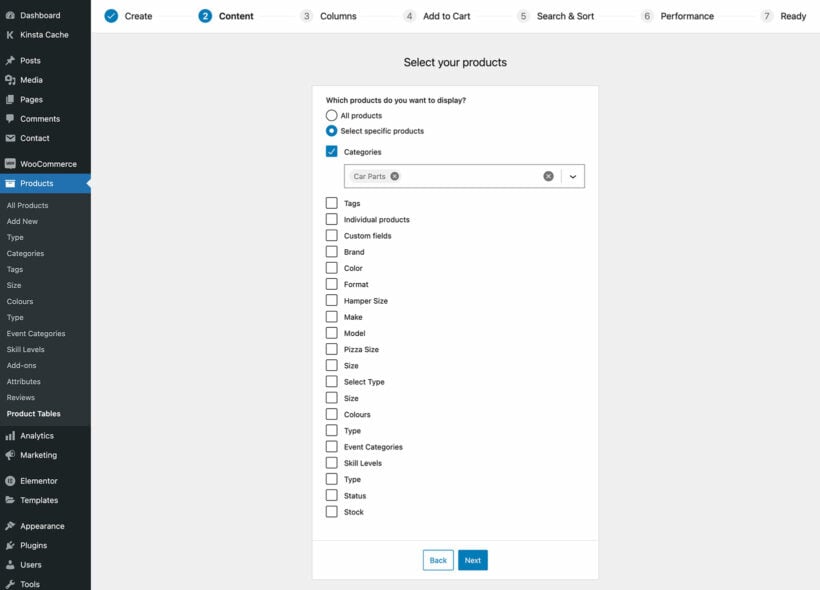
The final page of the table builder will provide a shortcode for adding the table to a page. Either insert this onto the page, or add a 'Product Table' Gutenberg block and select the table you just created.

The page will then display a product table complete with columns for the WooCommerce custom taxonomies.
How to show WooCommerce custom taxonomies on the single product page
You can also use the shortcode method described above to show custom taxonomies on the single product page. However, you need to do it a bit differently because we only want to show one product in each table.
This time, use the 'Select products' page of the table builder to select which individual product you'll be displaying the WooCommerce custom taxonomies on.

On the 'Columns' page of the table builder, add custom taxonomy columns and don't bother with other columns like 'Name'. That's because this information is already present on the single product page.
You can then paste the table's shortcode onto the single product page, for example in the short description field. This will display the WooCommerce custom taxonomies for the selected product. In this screenshot, there are columns for a custom field called 'size', a custom taxonomy called 'fabric', and a stock column. I have hidden elements such as the search box which aren't needed on the single product page (you can do this at Products → Product Tables → Settings).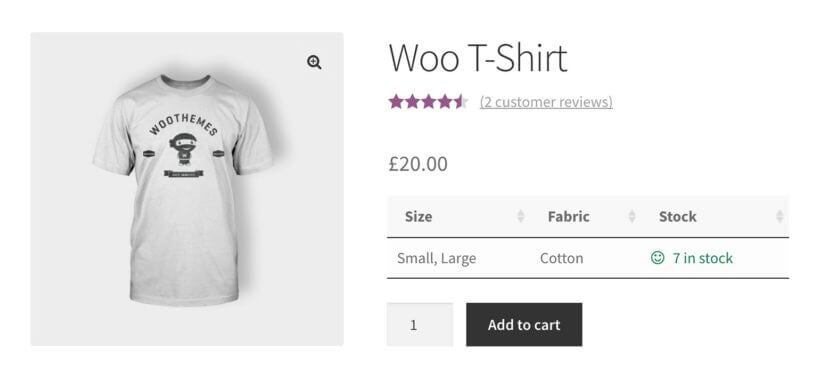
List WooCommerce products with a specific custom taxonomy term
By default, your WooCommerce product tables will list all the products in a table. This is perfect if you plan to have a single table listing your entire WooCommerce inventory.
However, you can also create product tables listing products from a specific category, tag, custom field, or WooCommerce custom taxonomy term.
To do this, use the 'Select products' page of the table builder to select which taxonomy terms you want to display the products for. When you enable the 'Select specific products' option, the list will automatically include all the custom taxonomies for the 'Products' post type on your store. Select a taxonomy (e.g. Brand in the screenshot below) and then which term(s) you wish to display the products for ('Woo' or 'Ninja' in my example).
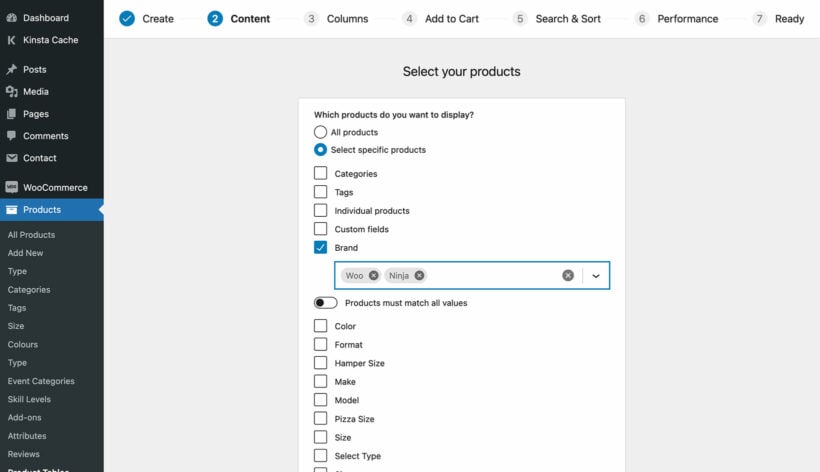
Let customers filter by WooCommerce taxonomy
So far, we've talked about how to display WooCommerce custom taxonomies on your website. In addition to this, your customers can benefit from being able to filter the list of products by taxonomy. Product filter by custom taxonomy allows customers to easily find whatever product they're looking for.
There are two ways to add taxonomy filters, depending on whether or not you're already using WooCommerce Product Table to display your taxonomies.
Use WooCommerce Product Table to add taxonomy filter dropdowns
WooCommerce Product Table comes with taxonomy filters which you can display as dropdown lists above the list of products. You can add a separate filter for each custom taxonomy (plus other data such as attributes, variations, categories and tags - instructions here). Customers choose a taxonomy term from the dropdown and use it to filter the list of products.
You can create WooCommerce product filter by custom taxonomy in the table builder. Your WooCommerce custom taxonomies will appear in the list of available filters. Add as many as you like.

Add advanced WooCommerce taxonomy filters with the Product Filter plugin
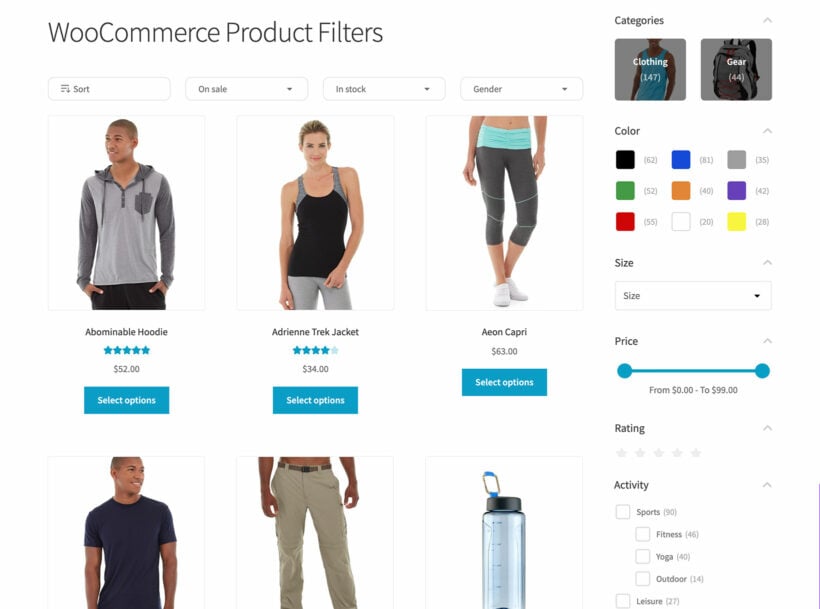
For more advanced and flexible custom taxonomy filters, you can use the WooCommerce Product Filters plugin. This comes with many taxonomy filters, including checkboxes, radio buttons, clickable images, range sliders, and much more.
The WooCommerce Product Filters plugin offers a wide range of customization options for displaying taxonomy filters. You can choose from different styles such as checkboxes, dropdowns, images, image labels, or even color swatches. This means that you can create a taxonomy filter that matches your store's design and makes it easy for customers to find the products they are looking for.
For example, if you have a clothing store and want to allow customers to filter products by color, you could use color swatches as the taxonomy filter. This way, customers can easily click on the color swatch they want and see all the products available in that color.
Alternatively, if you have a store that sells products of different sizes, you could use a dropdown menu as the taxonomy filter. This would allow customers to select their preferred size and see all the products available in that size.
Add and edit custom taxonomies for products in bulk
Finally, let's talk about what happens if you want to add lots of taxonomies to your products. It can be a pain to add and remove them from each taxonomy individually, but you can save time by using the Setary app.
Setary is a bulk product editor for WooCommerce. It lets you edit any type of product data, including - you guessed it - custom taxonomies. You can either do this from a spreadsheet-style interface, or by filtering to select certain products and bulk-applying the taxonomies to them. Either way, it's a huge time-saver if you need to add or remove taxonomies in bulk.
If you've used a separate plugin to add your taxonomies then you need to enable in Setary. To do this, go to WooCommerce → Settings → Advanced → Setary and select the plugin that you used to add the custom taxonomies to WooCommerce:
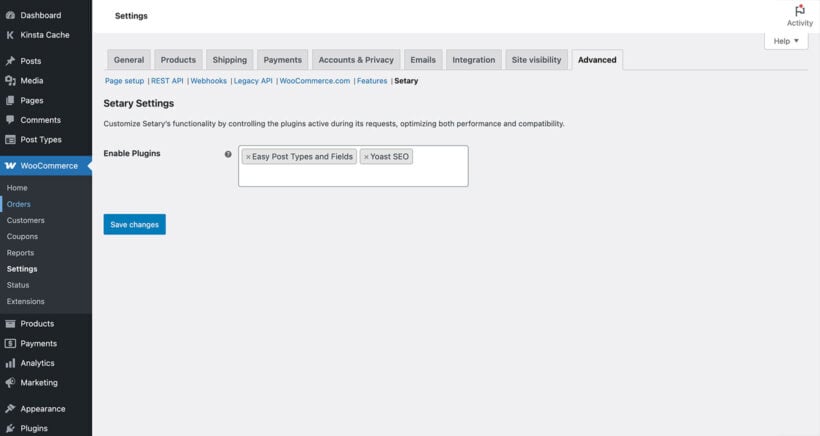
You can then select the taxonomies to include as columns in Setary's spreadsheet editor:
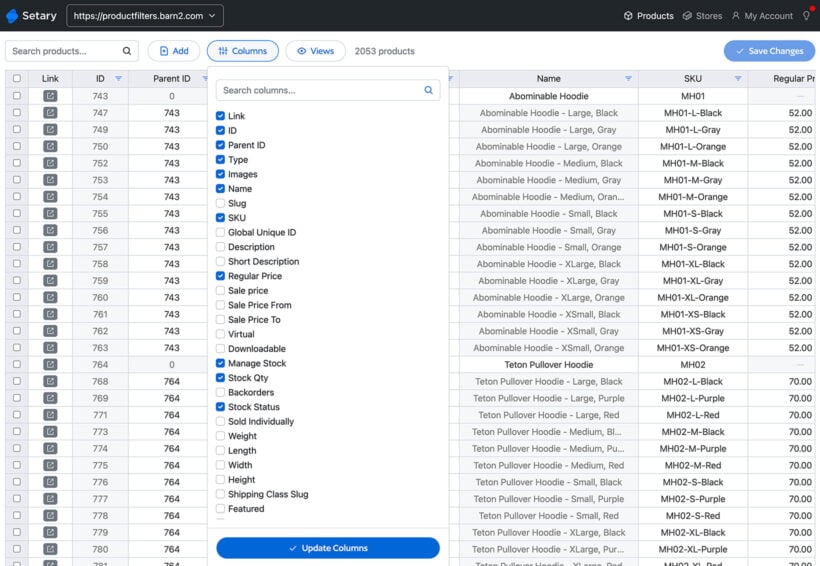
Take control over your WooCommerce product taxonomies
In this article, we have covered the best plugins for adding and displaying product taxonomies in your WooCommerce store:
- The free Easy Post Types and Fields plugin makes it easy to add custom taxonomies to your WooCommerce products.
- WooCommerce Product Table displays taxonomies on the front end of your website. You can do this on the single product page, your main shop pages, individual product pages, and list products by taxonomy.
- The WooCommerce Product Filters plugin adds advanced filters so that customers can find products based on their taxonomy terms.
- Setary App lets you add and remove custom taxonomies from WooCommerce products in bulk, saving hours of manual work.
Armed with these tools, you can add a wide range of custom data to your products and take your store to new levels of success. Mix and match the plugins to get the full benefits of WooCommerce custom taxonomies in your store. The possibilities are endless!
30 Comments
I have one question. I have problems to understand why custom taxonomy is used for color and not product attribute. So if you have product with three distinct "Values" you want to group products by, like Color, Smell and Material type, what are the pros and cons of using product attributes vs custom taxonomy?
Thank you very much,
Viktor
Thank you, this is useful.
Hi, Abzardooni! Thanks for your kind words. Should you be interested in any of our professional, high-quality, and lovingly handcrafted plugins for WordPress and WooCommerce, feel free to reach out to us at our Support Center. Have a great day!
We are just developing something on woocommerce for selling premium domain names and I was wondering what way will be best to describe each domain. Categories and tags were not enough, so I focused on product attributes but the problem with them is that if you are uploading products with .csv you need 4 columns for every attribute. One with the name of the attr, second with its value(s), third to tell woo that it’s visible (value 0 or 1) and fourth column to tell woo that the attr is global (value 0 or 1). Reading this I started wondering if creating custom taxonomy is not actually much much better solution. Are these new taxonomies described by only 1 column if you upload products with .csv?
Hi, Anton. My apologies for the late reply and thanks for your comment.
For details about the .csv file format or columns for custom taxonomies added to the WooCommerce product post type, I suggest you contact WooCommerce Support or refer to the official WooCommerce Docs about Importing Products.
I hope this helps point you in the right direction. Let me know if you have any other questions. You can also get in touch with us much quicker via our dedicated Support Center.
Hello, i have the custome taxonomy "brands", but i change the poermalink/slug for "marca", when i aply in the shortcode tax:marca, doesent work, not show the colum.... any idea why??
Hello, Alejandro. I'm sorry to hear you're having difficulty with what sounds to be displaying a custom taxonomy column in the product table on your site. So that we may assist you best, please could you fill up a tech issue form with the details regarding your concern at our Support Center. Many thanks.
Hi Katie,
Thank you for your speedy reply. The custom field plug in we are using is: Woocommerce Custom Fields by Rightpress. Are you familiar with this one? You are absolutely correct about the difficulty in trying to use a table for multiple products. My customer wants to use the table on a single product page where their customers can dial in the variations they need in ordering products, colors, sizes and other custom attributes. Do you see any other barriers we might encounter with your product?
You can use WooCommerce Product Table with any custom fields plugin. You just need to find out the correct name for the custom field so that you can list it as a column in the table.
To be honest, using WooCommerce without any extra plugins might potentially cause performance issues on the single product page if a product had 500 variations. If you use WooCommerce Product Table to list the same number of variations then it should take about the same time to load. What matters is the amount of data being loaded with the initial page load, rather than the exact method.
As you probably know, variations can be a nightmare to manage if you have lots of them. It's worth checking out the Product Add-Ons plugin which makes is slightly easier to manage large numbers of options, and ha a copy and paste feature which makes it easy to copy add-ons between products. We have fully integrated WooCommerce Product Table with Product Add-Ons and you can use add-ons with simple or variable products.
I have a question before I buy. Is there a conflict between custom fields and your plugin. My customer would like to replace the default drop down options shown in woocommerce for product variations in a table. His products require some custom fields such as custom printing, specific date and upload customer logo. He sells products with over 500 variations on some products. He is interested in making it easy for a customer to quickly select his selections using variations listed in a table or with drop downs in table format. Thank you.
Hi Rick, WooCommerce Product Table fully supports the Advanced Custom Fields plugin and you can display your custom fields as columns in the table. We have also tested with Toolset Types, Custom Post Type UI and Pods and found that they all work nicely with WooCommerce Product Table.
You can add attribute/variation filter dropdowns above the table or to a sidebar widget. You can also add variation dropdowns to the add to cart column of the product table. However, please be aware that 500 variations for a single product is a HUGE amount of data to load all at once, and may cause performance issues. This would also happen if you listed so many variations on the single product page, but it could be worse in a product table because you are listing multiple products on one page. If this is a problem then you can always disable the variation dropdowns so that customers can click through to the single product page to choose their variations. In the next few months we also plan to add a 'Quick View' option that lets people click on a button to view more information and select variations from a lightbox, so this might be a good option for your customer.
WooCommerce Product Table has a lazy load option which loads one page of products at a time, so this might help. Please bear in mind that we have a 30-day money back guarantee so you can try the plugin risk-free.
Much of what you discuss could have been done with the old Attribute feature, but now they have removed the ability to have free text strings. Two use cases I have discussed with the WooCommerce team that they have killed recently by removing the ability to have "select" and "text" type Attributes:
1) Product Cross-Numbers : Every technical product (e.g. engine parts, machine part, etc.) has a product number. Not only that, but it has cross numbers. So a Wix filter will have Baldwin, Napa, Donaldson, Fram, et. al. crosses. They each have their own product number that crosses to each other. Question: How would you recommend displaying this information to a customer in a structured, consistent way? The former Attribute feature allowed this easily. That said, I get that storing 2,000 unique values under an Attribute called: "Other Product Numbers" would pile up the values, but your solution might not be the best solution. I would suggest that you allow, as before, the ability to make an Attribute "Selectable" or "Text". If, text, you should turn off the Attribute value features and simply keep the Attribute as a free text string. What this solution would enable is 1) Enforcement of a consistent Attribute title on the front-end such as: "Other Product Numbers;" 2) It also enforces the person creating products on the back-end a reminder that that value, which would appear in a drop-down of Attributes, would be required (not technically, but via workflow -- namely, it's a configured Attribute name in the drop-down. Without enforcement of the Attribute value, there is no way to ensure a consistent end-user experience on the front-end. Now we will have various product creators creating ad hoc (what you call "custom") Attribute names such as "Other Product Numbers," "Crosses," "Other Numbers," not to mention mispellings. When you have 1,000's of products, you can see that there is no way to enforce this on the backend with multiple product creators. I would argue that you threw the baby out with the bath water. You solved one problem (proliferation of Attribute values), but killed a very valuable feature that allowed free text strings against an enforce Attribute name (e.g. "Other Product Numbers"). I would also argue that you might have lost sight of the original use-cases that built the Attribute feature in the first place and why they allowed text strings versus only a tag structure. Most of my clients are parts suppliers and cross-reference numbers are the life-blood of optimal SEO and marketing. Now we have no way to do this, but we did. So the ability to enforce consistent Attribute names is no longer available. To accuse me of product misuse, is simply not productive. There is no other way to use WooCommerce for the parts industry. Tags and Categories don't work. Free text in the product description and Free text via the Custom Attribute is too loosely-goosey to enforce a consistent backend workflow and consistent front-end experience. Take this as an example from a filter on Amazon. I used to be able to mimic this 100%. Now it's impossible in a scalable way. Practically every single product in Amazon requires this feature! Please tell me how I am supposed to mimic this?
2) Maintaining consistent private notes: The same old feature was able to accomplish this, just a different use case. Attribute enforcement of a private value (e.g. Source). This is the private source for a product I sell that has replenishment details. Yes, this might not be a color, size, etc. But a critical piece of our business. People that maintain complex catalogs of products with multiple suppliers, need to keep track of where they buy their products and other details. Again, this was supported via the no-publish feature, which you still have, but now their is no way to enforce the Attribute name (just like #1).
I get that there was a proliferation of Attribute values. But the way to fix it would be to align the following:
>> If Attribute type was "text", turn off the ability to create and manage formal values (i.e. the backend is just a text string)
>> If Attribute type was "select," the keep the ability to create and manage formal values (e.g. color, size, etc.)
>> Keep the ability as you have today of publishing or not publishing the value.
My parts customers are pissed to no end. This will be hours and hours of work to clean up 10,000 products across 10 customers and even then, there is still no way to enforce Attribute names on the front-end. We may ditch WooCommerce and migrate off the platform as this is unworkable for us and not sure if any plugin can fix this without complicating the back-end and front-end code.
I would venture to guess, that EVERY single product listing on Amazon could not be replicated in WooCommerce due to the above. Every product has UPC, NSN, ASIN, etc. etc. product codes. There is NO way to replicate this functionality in WooCommerce now and that is a massive issue. I don't think users have actually realized what happened and you will receive more and more complaints related to this. It took me a while to figure out what broke.
Thank you for listening and your patience. This is such a big issue for us that it may require us to find a new ecommerce plugin to WooCommerce as it seems the engineers/product folks have broken a feature more than fixed it and have completely made it impossible to mimic the most basic of product listings (enforced Attribute names, with free text values).
Wow, I think that is the most in-depth comment anyone has ever left on this blog! You're right, it's a shame that you can't use attributes to do all these things. WooCommerce seems to think that an attribute is just for listing data about products, when some sites were using them for much more than this.
Thanks for the quick reply!
I have done what you suggested and worked perfectly.
After that I bought your Product Table plugin and it is awesome, thank you very much! I probably contact you in a few weeks for other things I will need in the page... like wholesale password store...
Cheers,
Guillermo
Hello,
I needed exactly this: Extra Product Data & Filters!!! and you helped me do it finally!! Thank you!!
I have a site that has more than 1000 products and I have about 10 custom fields and other 10 taxonomies, I am trying to import the products through Products/import and I am able to do it through a cvs file but I don't see the mapping for the created custom fields and taxonomies.
Is there a way to import all the custom fields and taxonomies? or after I import the products I have to enter the fields and taxonomies by hand?
Cheers!
Guillermo
Hi Guillermo, glad it was helpful. The built-in importer doesn't support custom fields and taxonomies. You can do this using the official Product CSV Import Suite plugin, which has more features.
Hi Folks, I want to be able to do a Bulk Export / Import of the taxonomies using the Plugin. Is this possible? When I tried to use WC Store Export, it doesn't have an option to export the Taxonomies I created. Similarly for importing. ideas? Thanks
Hi Stuart, our plugin just displays custom taxonomies that are already on your site. I had a quick look and couldn't see any plugins for exporting WooCommerce product taxonomies, but this article has some advice on how to do it yourself.
Hi
I'm not interesting to use any plugin. So how can add without plugin
Hi Abdul, you can get your developer to create custom fields and taxonomies programmatically if you don't want to use a plugin. Most developers use Advanced Custom Fields to create their custom fields, but often create taxonomies without a plugin. Here's a Stack Overflow link to creating custom taxonomies - stackoverflow.com/questions/22791121/how-to-add-new-custom-field-taxonomy-in-woocomerce.
Katie,
I am searching for the right plug in(s) to achieve the following:
A. Add a custom field in the woocommerce product page for our "Primary Vendor" and possibly another for a "Secondary Vendor". These field need to be displayed in the admin orders only. Then our staff can see who we buy these items from and forward the appropriate order to them. Everything we do is drop shipped. We do not want this info to appear in the front end or on the customer's order emails. I can't seem to find the right plugin(s) to do this. Thank you in advance...
Hi Jeff, when you create a custom field using any plugin (e.g. Toolset Types or Advanced Custom Fields), it is added to the back end for each product but not he front end. You would need to do some custom coding to add this to the admin orders, I'm not aware of any off-the-shelf plugins that can do this. If you don't know how to do this yourself, I recommend posting a job on Codeable. Their pre-approved WordPress experts are fantastic for small customisations like this.
Hi, Katie,
If user buy products in multiply of 6 then 1 kr for shopping beg will add and we also need to add 25% tax on it. Can you help please..
Hi Joy, you should be able to do this through the WooCommerce tax settings. There are plugins such as Min/Max Quantities for WooCommerce if you want to force customers to buy in multiples of 6.
tanks a lot Katie,
this article was useful for me.
Hi Katie
I was trying to use the ACF function to add fields for "Name of Bride & Groom" & "Date of Wedding" on a specific category of products only in my Woo site, but this seems to be limited to adding those globally to all products? Have I understood that right? Is there a better way for me to add these fields to one category of products only.
Thanks for your help.
Kind regards
Mark
Hi Mark, by default adding a custom field to the 'Products' post type will add it to all products. However, you can leave the custom field box blank for the products in your other categories. Depending on how you're displaying the custom fields in the front end of your website, you might need to do some custom coding to only show the custom fields on the front end product pages for those categories.
Great tutorial! This is really helpful to used my business site development. It is very simple.
Thanks.
Hi, would like to know how to add woocommerce product table on search result pages? have checked the knowledgebase already.
Hi Abby, WooCommerce Product Table doesn't integrate with the main WordPress search or the WooCommerce Product Search.
You couldn't add it to the main WordPress search as those contain other types of content and not just products. You could probably modify the product search results template to include a product table. This wouldn't come under our standard support so please let me know if you'd like a quote for this from our customizations service.